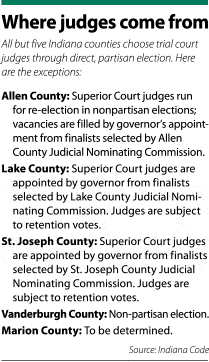Dave Stafford for www.theindianalawayer.com
Now that Indianapolis’ pay-to-play slating system that evenly divvied judgeships between Democrats and Republicans has been ruled unconstitutional, it’s up to the General Assembly to figure out how Marion County should select its judges.
Key lawmakers suggested there’s no rush to find a fix, though, because the next Marion Superior judicial election won’t happen until 2018. If legislators follow systems enacted for larger counties such as Lake, Allen and St. Joseph, merit selection could determine future Indianapolis judges, but that’s far from a given.
Sen. Brent Steele, R-Bedford, chairs the Interim Study Committee on Courts and the Judiciary. He said he didn’t expect the 7th Circuit Court of Appeals ruling striking down Marion Superior elections will be discussed in either of the committee’s two remaining 2015 meetings.
Sen. Michael R. Young, an Indianapolis Republican who serves on the Judiciary Committee, said it’s too early to tell whether there will be proposals to revamp the Marion County system in the upcoming session because there’s still time for the decision to be appealed.
The office of Indiana Attorney General Greg Zoeller could not indicate by IL deadline whether the state would appeal the ruling.
“Before anything’s decided, what we’ll do is get together both political parties, the judges involved, and try to discuss it and see what’s fair,†Young said. He isn’t philosophically opposed to merit selection, he
said, but noted, “My personal thought is we try to find a solution within the system we have now, making people’s votes meaningful and keeping the decision with the voters.â€
Of Indiana’s 92 counties, 87 select judges through direct, partisan election. While it’s unclear what will replace Marion County’s current system designed to ensure partisan balance, some close to the process say it is unlikely changes will result in Indianapolis voters filling in unrestricted partisan ballots to elect Superior Court judges.
While heavily Democratic Marion County is the largest judicial circuit in the state, it also oversees a unique docket. Superior courts in the state capital handle appeals from state agency actions, and those decisions can have statewide implications. This special situation could prompt lawmakers to fashion a system in which the Legislature has a greater say in judicial appointments.

Geyh
Indiana University Maurer School of Law professor Charles Geyh, an authority on judicial selection, said it’s possible lawmakers could craft a system in which the state Senate or designated body serves in an advise-and-consent role on choosing judges, and he believes that sort of system would withstand constitutional scrutiny. But, he said he couldn’t hazard a guess as to what is likely to replace the system ruled unconstitutional.
Geyh noted the merit selection movement nationally has stalled in recent years, so it’s far from a sure bet lawmakers would enact such a system in Indianapolis. The task for legislators, he said, is finding a system that strikes the proper balance between judicial independence and public accountability.
 “Marion County had a thoroughly wonky system for selecting judges,†Geyh said. “It was originally designed to keep the process from getting political. The net effect of trying to make it less politically partisan is the parties basically dictated judgeships and voters had basically nothing to say.â€
“Marion County had a thoroughly wonky system for selecting judges,†Geyh said. “It was originally designed to keep the process from getting political. The net effect of trying to make it less politically partisan is the parties basically dictated judgeships and voters had basically nothing to say.â€
That’s how the 7th Circuit Court of Appeals saw the system in its Sept. 9 opinion, affirming a ruling by Chief Judge Richard Young of the U.S. District Court for the Southern District of Indiana that the statute was unconstitutional.
“We agree with the district court that the Statute at issue burdens the right to cast a meaningful vote without sufficiently weighty interests to justify such a burden,†the 7th Circuit ruled in Common Cause Indiana v. Individual Members of the Indiana Election Commission, et al., 14-3300.
“We conclude that the precise interests (including partisan balance) put forward by the State do not justify the burden placed on the right to vote for judicial candidates for the Marion Superior Court. Therefore, the Statute violates the First and Fourteenth Amendments,†the panel held.
The election law that was struck down facilitated a system whereby both parties “slated†ballot positions with candidates who made five-figure financial contributions to the parties.
The slating process essentially made the general election pointless, because those candidates who won in primary elections were assured election because of the allocation of a set number of judgeships to each party. For instance, in a year where there was an election to fill 20 judicial positions, voters received ballots in which they could vote for up to 20 candidates, but only 10 Republicans and 10 Democrats were listed on the ballot.

Schumm
Indiana University Robert H. McKinney School of Law professor Joel Schumm said Marion County party chairs spoke to students in his judicial selection course after the 7th Circuit opinion.
While the system was flawed, he said, “There are advantages and disadvantages to every system. We’ll end up with some sort of a system, and it’s not going to be a perfect system.â€
Schumm said slating kept a lid on the amount of money judicial candidates had to raise in Marion County, in contrast to judges from other counties who’ve told his class they needed to raise in excess of $60,000 for campaigns. Merit selection has shortcomings, too, he said, noting he’s unaware of any judge at any level in Indiana who’s ever lost a retention vote.
The system in Marion County was so unique, Schumm said, that even election law experts disagree about whether the 7th Circuit opinion was an unusual reach into the conduct of local elections. Nevertheless, he said there could be dangers if the current system is only slightly modified.
“If the goal of this is some sort of partisan balance, the court doesn’t seem to buy that argument,†he said. “I don’t know that that’s going to pass muster.â€
Marion County “has a system that’s unique in the country and clearly creates a non-election,†said Ken Falk, legal director of the American Civil Liberties Union of Indiana, which represented Common Cause. “If the right to vote is going to mean anything, it means the right to a meaningful election.â€
“There is no more important right in our Constitution than that of exercising a meaningful vote,†Falk said. “We are very pleased that the Court’s decision forcefully reaffirms that right.â€
The 7th Circuit agreed with Young’s ruling that the statute was unconstitutional on its face and that Common Cause was entitled to summary judgment. In most cases under the Partisan Balance Statute, I.C. 33-33-49-13, “So long as each candidate votes for himself or herself, as he or she presumably will, actions taken by other voters in the general election are meaningless, as they lack any opportunity to affect the outcome,†wrote Judge Theresa Springmann of the U.S. District Court for the Northern District of Indiana, sitting by designation on the panel.
The panel rejected the state’s argument that races could be contested by independent or minor-party candidates. “It does not alter the fundamental nature of the Statute — to reduce electoral choice and the availability of what would otherwise be contested elections in the interest of preserving partisan balance.†The panel held that the statute also “interferes with the marketplace†by restricting the number of candidates each party may nominate.
The system “could be viewed as ultra-partisan,†according to the panel.
“Such a system creates the perception that a judge is chosen within the primaries, not the general election, and if a judicial candidate’s eventual election is dependent solely on the primary, the candidate’s chances of being elected improve the more he appears to espouse the ideals of the party,†Springmann wrote.
And because judicial candidates are “slated†by parties after making contributions of about $12,000 to $14,000 to the local parties, “the candidate could consider himself indebted to the party. His best chance at winning the election is to earn a spot on the party’s slate of preferred candidates,†Springmann wrote.•



 Geyh
Geyh “Marion County had a thoroughly wonky system for selecting judges,†Geyh said. “It was originally designed to keep the process from getting political. The net effect of trying to make it less politically partisan is the parties basically dictated judgeships and voters had basically nothing to say.â€
“Marion County had a thoroughly wonky system for selecting judges,†Geyh said. “It was originally designed to keep the process from getting political. The net effect of trying to make it less politically partisan is the parties basically dictated judgeships and voters had basically nothing to say.â€ Schumm
Schumm